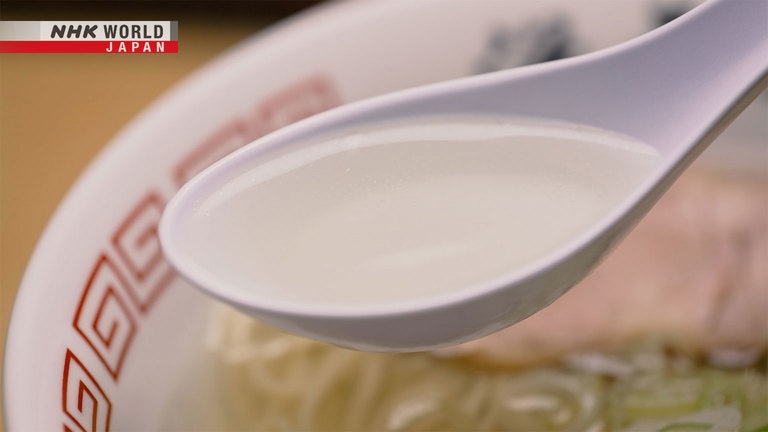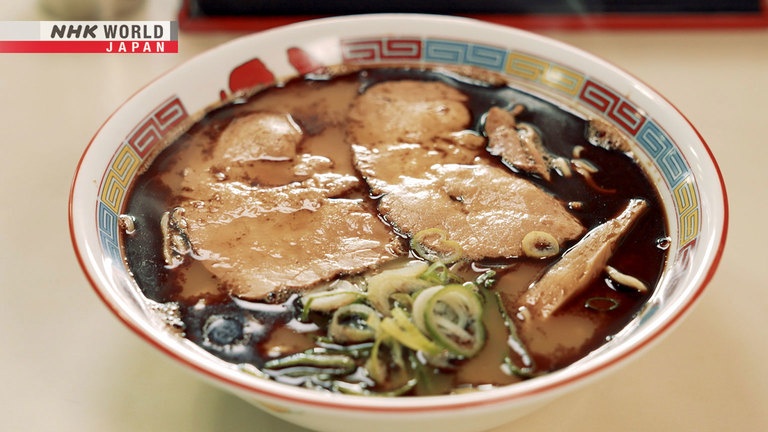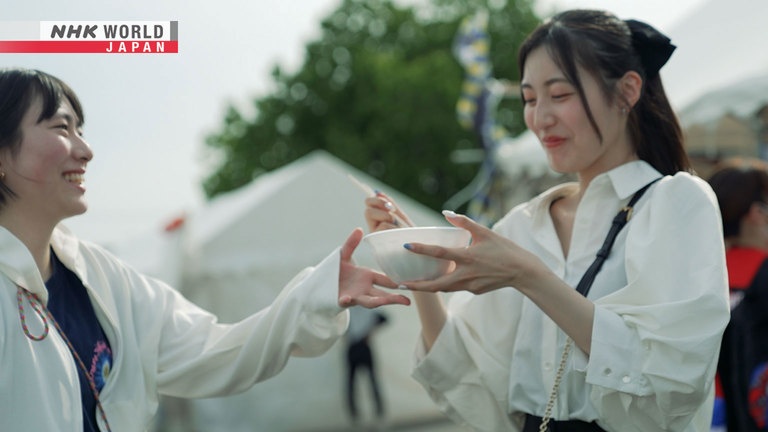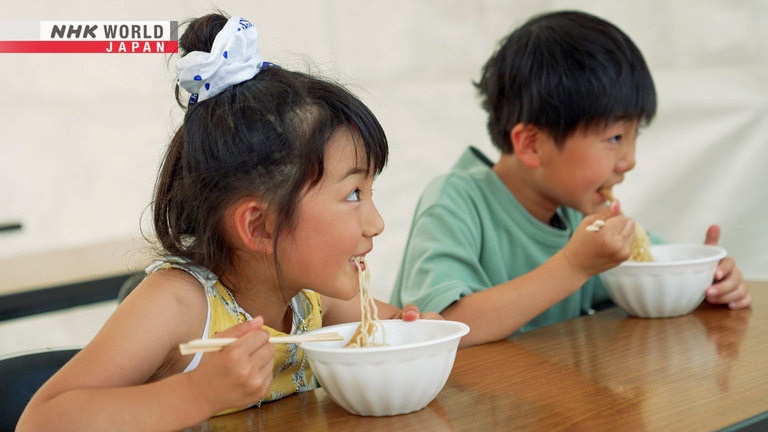HOKKAIDO Part 2
Hakodate and Asahikawa ramen, enjoy a hot helping of both! College kids give their all to a summer of ramen.




Transcript
Ramen...
A Japanese staple that's now popular worldwide.
Each region has its own vision, shifting with the times while staying true to the original.
Welcome to Japan, the land of ramen!
This is part 2 of our tour of Hokkaido.
As our journey continues, we sample ramen from Hakodate and Asahikawa.
Our first stop: the southern port city of Hakodate.
Home to around 240,000 people, it's Hokkaido's third largest city.
At 6:00 am, the morning market is in full swing.
In search of the freshest ingredients, visitors come here from all over the world.
Of course, there's also ramen...
And in Hakodate... that means salt, or "shio" style!
We'll learn about the best bowls in town from an expert.
Matsuda Masahiro, born and raised in Hakodate, and a local taxi driver for 27 years.
The soup for Hakodate "shio" ramen
has to be clear, never cloudy.
The toppings are also very simple.
Matsuda's taxi is a bit unusual.
It has a bowl of ramen as a roof light.
And it even has a name...
The Fabulous Shio Ramen Taxi!
The one-and-only Hakodate "shio" ramen taxi!
The drivers know all the best local spots to introduce to their passengers.
And Matsuda is one of them.
There's a delicious "shio" ramen shop
that's been open since the old days.
As soon as it opens, hungry fans are already lining up.
Opened in 1947, it's one of the few local shops to preserve the spirit of the original Hakodate ramen.
It's operated by the Ouras.
For Hakodate ramen, it's all about the clear soup.
Our soup is especially clear.
Pork and chicken bones with kombu.
We make it as clear as possible.
It's the most time-consuming step.
His wife, Yumiko, is in charge of the soup.
If you're not careful to skim regularly
it'll quickly become cloudy.
She's at it from 7:00 am until closing time.
The key to its classic flavor...
Three per serving. That's it.
Just three teaspoons of salt.
They also make the noodles.
They're not too thick or too thin, medium.
Somewhere between Sapporo and Hakata.
The noodle machine we use is an old one.
It can't do that many portions at once
so we make what we can every day.
Toppings are just "chashu" pork, pickled
bamboo shoots and sliced spring onions.
The usual style at old shops like ours.
Since opening at 11:30 there's been a constant stream of customers.
It's light and delicious.
I took time off today and
made sure I was first in line.
I've been coming here 30 years now.
For me Hakodate means "shio" ramen.
But why is Hakodate ramen "shio" style?
In the 19th century, the shogunate had closed off Japan to the outside world,
but in 1859, trading ports were established in Nagasaki, Yokohama, and here in Hakodate.
Various nations opened consulates in Hakodate, and it rapidly developed an international character.
It soon became Hokkaido's most populous city.
This is a Hakodate newspaper from 1884.
There's a mention of "Nanking noodles"...
In other words, "ramen."
In fact, this is the oldest known advertisement for ramen in Japan.
The exact recipe isn't known, but it's believed to have been a salt-flavored noodle dish.
The dish was brought to Hakodate by Chinese merchants
who crossed the sea in search of the abundant local marine products.
They helped spread ramen culture throughout the area...
A trend continued by the Ouras' shop, and passed down to the present day.
My Japanese name is Oura,
but I used to be Sha Yoshiaki.
There are many Chinese living abroad
in this area, my father was one of them.
It was people from places like Taiwan
who first made "shio" ramen.
It's something from our childhood
that's still with us today.
There was no "shio ramen" really,
it was just "ramen."
Even now, if you ask for ramen,
"shio" ramen is what I'll serve.
Hakodate "shio" ramen: a living record of the taste of Japanese ramen at its beginning.
In central Hokkaido, the city of Asahikawa lies in a basin surrounded by mountains.
In 1902, it saw the lowest temperature ever recorded in Japan, at -41℃.
A record still unbroken for over 100 years.
And even in Japan's coldest city, ramen is a local favorite.
This facility is dedicated entirely to ramen.
Featuring eight different ramen shops, it sees over 100,000 visitors a year.
Asahikawa ramen's main feature is its distinctive soup.
It's actually a double soup.
The flavor comes from a blend of
"tonkotsu" and fish-based soups.
The blended soup is also topped with hot pork fat.
According to Professor Eguchi Naofumi who's studied ramen for nearly 20 years...
Asahikawa still regularly sees
temperatures below -20℃.
The rendered pork fat serves as
a sort of "lid" to keep it from getting cold.
This clever idea is characteristic
of Asahikawa ramen.
1947, two ramen shops open for business in Asahikawa.
This was the birth of Asahikawa ramen.
To uncover how one of its creators came up with this distinct taste,
we spoke to second-generation owner, Kato Naozumi.
We use a "tonkotsu" and
"aji" mackerel double soup.
First, we let both soups cool for a day.
This makes the "tonkotsu" less pungent
and gives it a lighter flavor.
This shop renders their own pork fat, but what exactly goes into it?
Scraps of back fat and meat mixed and heated.
Letting it char increases the sweetness
since we also add fish.
After simmering for six straight hours...
The pork fat "lid" for the soup is finally done.
This is the heart and soul.
Add the painstakingly rendered pork fat to the double soup
and you get... Asahikawa ramen.
I ate my first ramen right here.
It was the same for my daughter,
my son and my grandchildren.
In 1947, one of the people who helped bring Asahikawa ramen to the world was Kato Enao.
But the work he did before had nothing to do with ramen.
When dad came back from the war,
he just did ice cream in summer.
He heard of this thing popular in Tokyo,
some kind of Chinese noodles.
He'd never eaten or even seen them.
Using the stories he'd heard and his imagination, a whole year of trial and error followed.
It seemed that people in Hokkaido
didn't like the smell of "tonkotsu" at all.
Trying to eliminate the odor, he added
dried sardines and "aji" mackerel.
With that, the soup stock was complete.
At the time he offered two different flavors.
We started with "shoyu" and "shio."
"Shoyu" was the norm back when we opened.
Even now, it's about 70% of our orders.
The reason "shoyu" was so popular in Asahikawa was this sake brewery founded in 1890.
During WWII the brewing of sake was restricted so they had no choice but to switch to making soy sauce.
After the war, their soy sauce was used all over Asahikawa.
A major soy sauce maker had
been established in the area.
This is why "shoyu" ramen
became so popular here.
Their soy sauce is a mainstay of Asahikawa ramen to this day.
June 2023.
The day of Asahikawa City University's school festival.
How about some ramen?
A ramen stall operated by students; part of the festival for 19 years.
Here's your ramen.
This is the seminar group that will run the ramen stall.
Professor Eguchi is the group's advisor.
And the subject he actually teaches is business administration.
To help the students learn about business
we started a ramen shop they run themselves.
The student-made ramen begins with training at a long-established shop.
They learn that it's not just the product,
but things like cleaning and preparation
that are part of managing a business.
Everything form the soup, to the "chashu" pork and pickled bamboo shoots are made by the students.
A bowl of their ramen brings smiles to the faces of family, friends, and everyone who has one.
Hakodate, with its long history as a port town...
Asahikawa, in the bitter cold of central Hokkaido...
The unique ramen made in each city...
an inheritance to be treasured through generations.
Wouldn't you like some yourself?
Come pay a visit for the best bowl of ramen you've ever had!